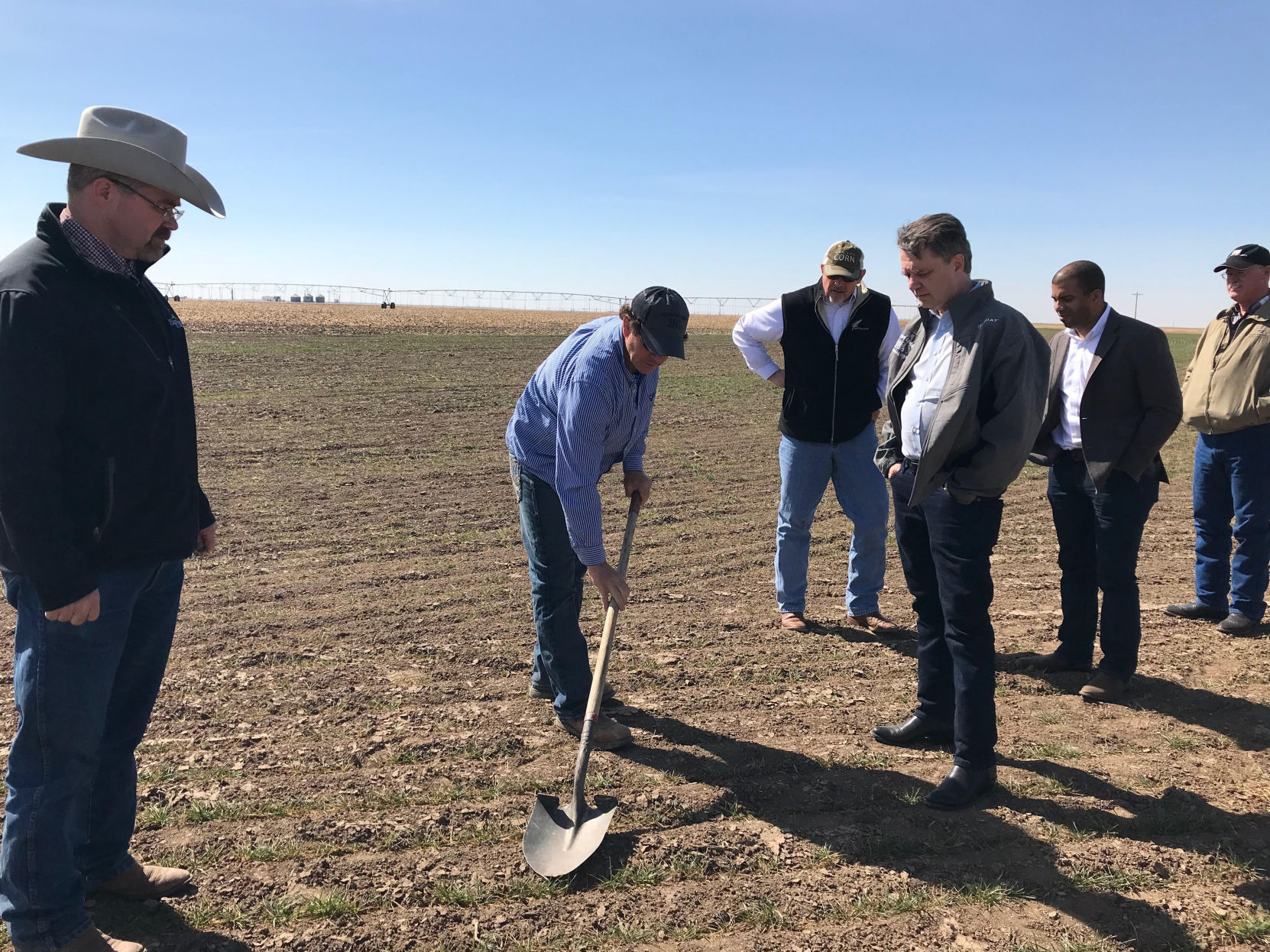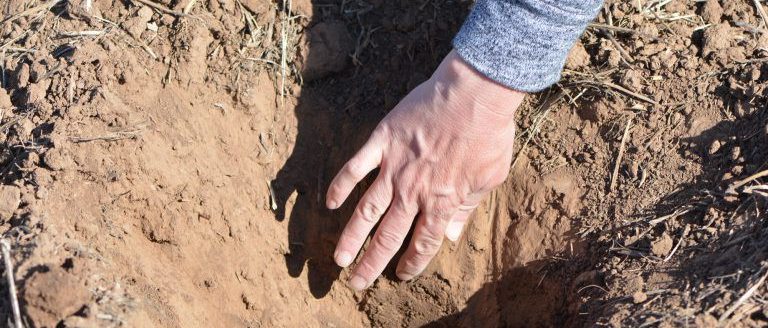Kansas Gov. Colyer sees view of the Southwest Kansas drought from the front lines

Dean Bird kicked his boot into the dry earth then plucked up a brown, shriveled stalk of winter wheat.
The farm manager for Clawson Ranch handed it to an awestruck Kansas governor.
“And this should all be green,” Gov. Jeff Colyer observed as he surveyed rancher David Clawson’s field of lifeless wheat near Plains, Kansas.
The June harvest is just a few months away, but the area hasn’t received rain since Bird planted the wheat crop in early October. Most likely, Bird said, the ranch’s few thousand dryland acres would not be harvested.
It was just one of the parched scenes Colyer saw as he toured the “front lines” of the southwest Kansas drought.
“This is almost to the point of no return,” Clawson told the governor.
The effects of the extended dry spell have left definite scars on the western Kansas prairie. The wheat crop is vanishing with each day of no rain, said Clawson, who lives near Englewood, Kansas. Pastures continue to decline because of the lack of moisture. Cool season grasses never came up.
If he could catch a rain, he could plant his burned-up wheat fields to grain sorghum in June, Clawson said.
“But, it all depends on rain, if we get the moisture,” he said.
Colyer issued a drought declaration March 13 for all 105 counties in Kansas, with 28 counties in the southwestern quarter of the state considered in “emergency” drought status. On March 15, Colyer and state leaders toured drought-stricken southwest Kansas.
“Southcentral Kansas and Southwest Kansas have been hit very hard very early on and it has the potential of expanding on farther north,” the governor said as he stood by the remains of a burned-out tree row along a road in Clark County. “We are here today to listen to folks and see what is happening on the ground here.”
Record-breaking season
As winds whipped above 25 mph and temperatures soared to a record 84 degrees, Colyer and the entourage traveled dirt roads through Meade and Clark counties, viewing wheat fields, along with some of Clawson’s pastures that burned in last spring’s Starbuck fire. A haze of dust filled the horizon, along with one small white cloud. Clouds, Bird noted, are a rarity.
“We are under a dome right now,” he said.
Droughts have come and gone in Kansas—especially in this seemingly arid southwestern corner of the state.
But Clawson said he has never experienced a winter like this one. There was no rain, no snow, not even an ice storm. In fact, Southcentral and Southwest Kansas posted the driest November through February period since reliable records began in 1895, according to the National Weather Service.
About 99 percent of the state is in some sort of drought, which intensifies as each week without moisture goes by. About 60 percent of Kansas is in a severe to exceptional drought.
The entire southern Wheat Belt is experiencing similar conditions.
Drought declaration
Colyer said his drought declaration directs state agencies to combat drought conditions. That includes opening federal Conservation Reserve Program acres for haying and grazing and temporarily suspends certain motor carrier rules and regulations to help expedite efforts to transport hay to livestock in drought-stricken areas.
Secretary of Agriculture Jackie McClaskey, also on the tour, said work was being done to contact Farm Service Agency county directors to encourage them to make requests to permit the use of CRP acres.
Joe Jury, an Ingalls-area farmer who was in the group, said he still is recovering from the 2011 and 2012 drought when he liquidated about 75 percent of his cowherd. It’s taken him six years to rebuild his herd to just 50 percent of what it was eight years ago.
Clawson said he normally would have cattle graze out some of his wheat through May. However, the conditions are too parched and he is destocking early.
Clawson said his worst wheat fields are ones he had to make one tillage pass on last summer. Normally he no-till farms his ground, but because of excessive herbicide-resistant weeds, he didn’t have a choice, he said.
After a wet spring in 2017, he thought he’d get moisture in the fall and winter. Instead, using tillage cost him moisture, he said.
He showed the governor his neighbor’s field across the road. The wheat on the no-till field is thin, but still green.
A good rain can still make a difference, Clawson said. The land can recover quickly. Rain would still help some of the wheat and rejuvenate pastures.
“This ground is really responsive to rain,” Clawson said, “if we can get a rain.”
Getting ahead of wildfires
Colyer also stopped at Gardiner Angus Ranch in Clark County, where 43,000 acres were scorched from the March 6, 2017, Starbuck fire. The Gardiners lost nearly 600 head of cattle and 270 miles of fence, Greg Gardiner said. His brother, Mark, lost his home.
More than 500,000 acres burned in Meade, Clark and Comanche counties from last year’s wildfire, making it the largest in Kansas history. Ranchers lost more than 4,100 acres of fence, along with thousands of cattle and homes.
Kendal Kay, the mayor of the Clark County seat of Ashland and the president of Stockgrowers State Bank, told Colyer many ranchers have rebuilt. About 95 percent of the fences have been replaced.
“Everybody stepped up in such a huge way,” said Kay of the countless volunteers and donations that funneled into the county.
Spring rains last year helped spur regrowth of the pastures, Gardiner said. But now, the ranch hasn’t had a rain since late September.
Colyer said he was concerned about the fire danger, noting several fires were already burning on that day. He said part of his goal is to get control of the fires early, which includes employing the Kansas National Guard as soon as fires flare up.
“In order to contain the fires, we need to work together—the National Guard, the Department of Transportation, forestry service and other groups—so we can head them of early on. Bringing in the Blackhawk helicopters so that they can help lift water very early and get after these fires is very important. It will help us, particularly on these days, these windy days where the fires can very quickly feed on all the fuel that is out there.”
The area hasn’t had a rain in six months, Colyer reiterated.
“We see greater risk,” he said. “We are in a very dangerous time. We don’t want this to happen again, we want to make sure we get ahead of it.”
The work Colyer touted was already happening just 50 miles down the road in Kiowa County. As Colyer and his team flew out of the Meade, Kansas, airport on the evening of March 15, Blackhawk helicopters were dumping water from Greensburg’s city lake onto a wildfire that started near Mullinville.
Amy Bickel can be reached at 620-860-9433 or [email protected].


